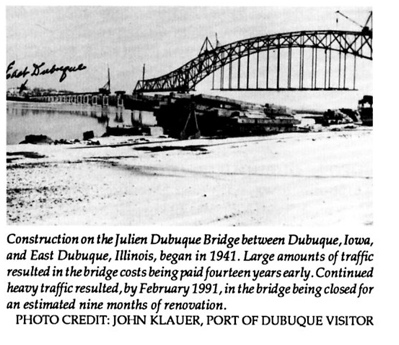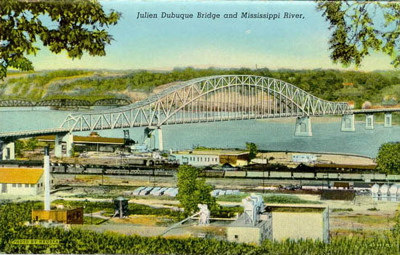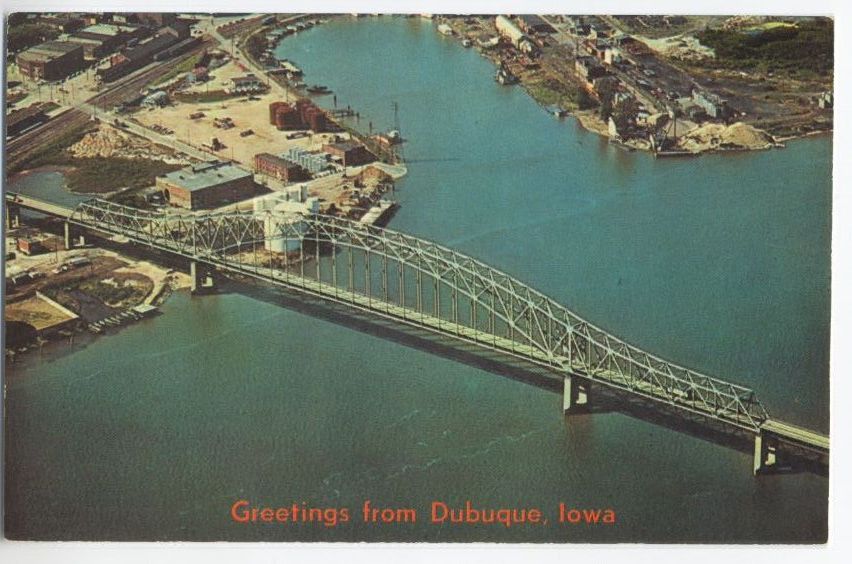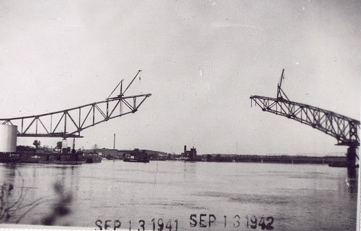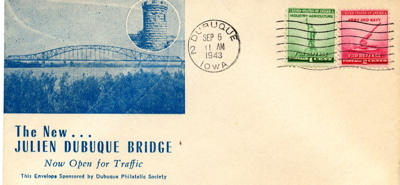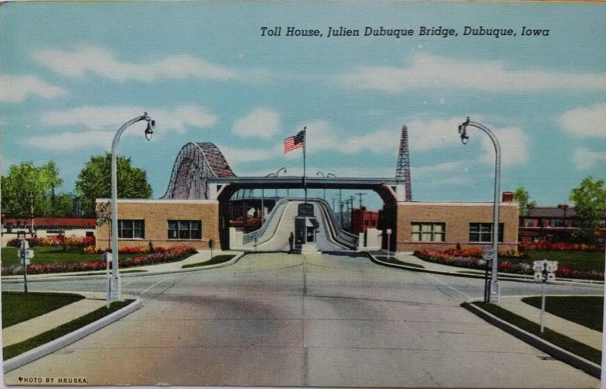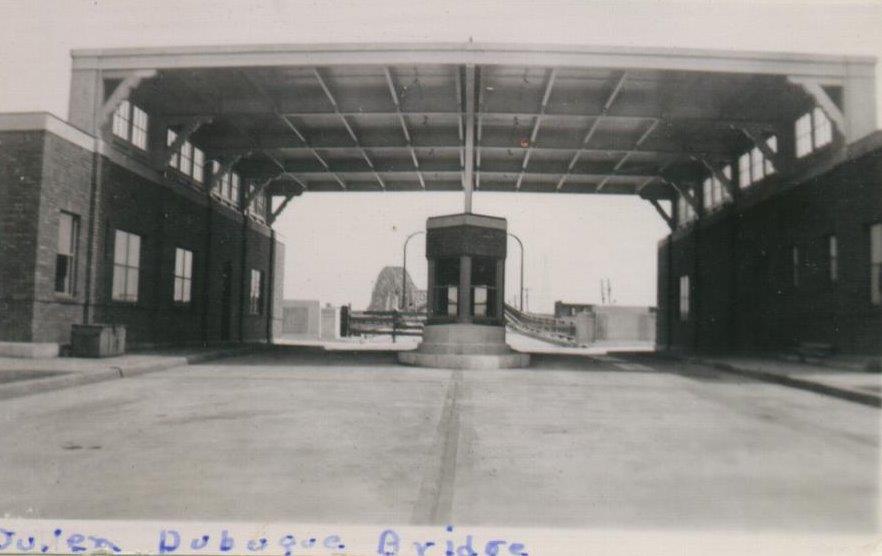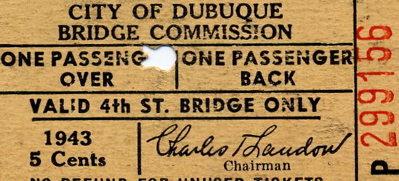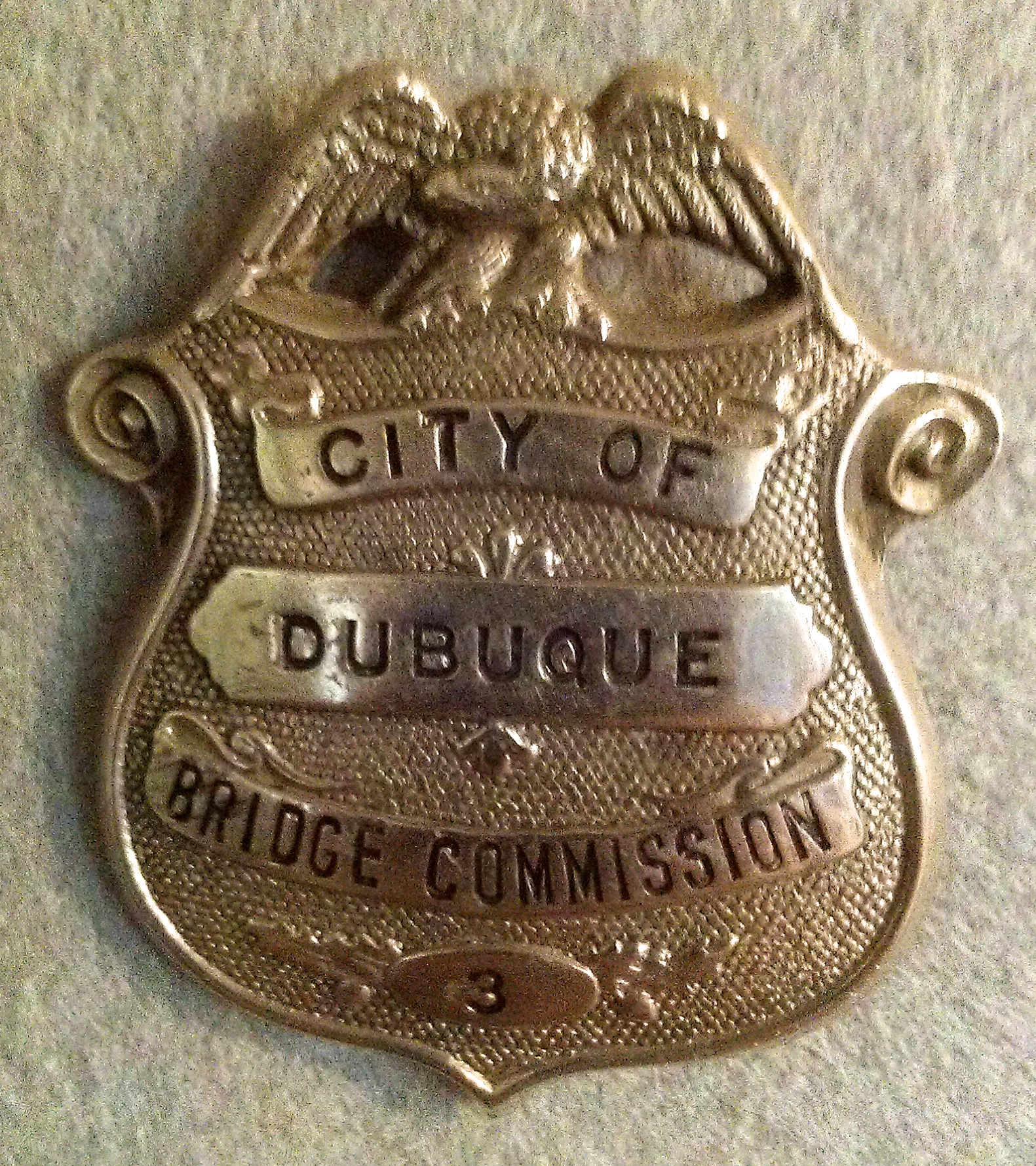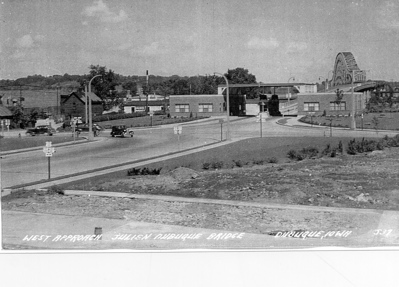Encyclopedia Dubuque
"Encyclopedia Dubuque is the online authority for all things Dubuque, written by the people who know the city best.”
Marshall Cohen—researcher and producer, CNN
Affiliated with the Local History Network of the State Historical Society of Iowa, and the Iowa Museum Association.
JULIEN DUBUQUE BRIDGE: Difference between revisions
No edit summary |
No edit summary |
||
| Line 31: | Line 31: | ||
With the completion of the Julien Dubuque Bridge, the [[DUBUQUE WAGON BRIDGE]], a wooden toll bridge south of the Illinois Central railroad bridge was purchased for just less than $500,000 and then torn down in 1944. (9) | With the completion of the Julien Dubuque Bridge, the [[DUBUQUE WAGON BRIDGE]], a wooden toll bridge south of the Illinois Central railroad bridge was purchased for just less than $500,000 and then torn down in 1944. (9) | ||
[[File:tollbooth2.png| | [[File:tollbooth2.png|250px|thumb|left|Toll house.]] | ||
[[Image:PFEILER1.jpg|left|thumb|250px|Toll house on the approach to the Julien Dubuque Bridge. Photo courtesy: Lucille (Hoffmann) Klein and Carol Pfeiler]] | [[Image:PFEILER1.jpg|left|thumb|250px|Toll house on the approach to the Julien Dubuque Bridge. Photo courtesy: Lucille (Hoffmann) Klein and Carol Pfeiler]] | ||
[[Image:imp254.jpg|left|thumb|250px|Photo courtesy: Bob Reding]] | [[Image:imp254.jpg|left|thumb|250px|Photo courtesy: Bob Reding]] | ||
Revision as of 02:06, 9 November 2014
JULIEN DUBUQUE BRIDGE. By 1936, the HIGH BRIDGE was forty-nine years old. Believing a new bridge would be a good idea began with the Community Service Commission of the Dubuque Post of the American Legion. (1) In 1938 the Legion joined forces with the Chamber of Commerce to advance the idea.
On April 26, 1938 similar bills were introduced in the United States House and Senate to create a City of Dubuque Bridge Commission with five members who would direct the new bridge and its tolls. (2) Making up this commission were Charles G. KRETSCHMER, Charles T. Landon, William CLEMENS, Sr., William Edward ELLWANGER, Sr. and Thomas M. STAMPFER. Both houses approved the bill by June 10th and the issue was sent to President Franklin D. Roosevelt for final approval.
Problems began. The legislation provided for tax exempt bonds to be issued to fund the bridge. By the time the matter had reached the president, he had already expressed his opposition to tax-free bonds and vetoed the legislation. (3) In 1939 the bill was passed again with the bonds being taxable. Roosevelt signed the legislation on July 18, 1939, and the Commission was established two days later.
The location of the bridge posed problems. Supporters of the approach on East and West Sixth Street, East and West Third Street, and Jones Street all argued their cases. The Dodge Street entrance, however, preferred by the Iowa Highway Commission and the city bridge commission eventually won. Navigation interests and the city dock commission raised issues claiming the Dodge Street location would interfere with the municipal dock and freight barges. Changes in the plans were made to settle these issues.
Begun in April 1941, the construction of the new bridge began on both the eastern and western shores of the MISSISSIPPI RIVER and eventually met mid-stream. A four-lane bridge was discussed, but rejected due to cost. The Commission had to issue $2.8 million in bonds as only $700,000 came from the federal government.
Structural features of the bridge include: (4)
lowest part of the steel work---16 feet above the bridge roadway
highest point of the steel work---130 feet
top of the arch---156 feet above the river pool level
cantilever span---842 feet over the main river channel
The structure extended 6,400-feet and consumed seven thousand tons of structural steel, one thousand tons of reinforcing steel, two and one-half million linear feet of piling, and thirty thousand cubic yards of concrete. Because it was wartime, the bridge was painted gray to better camouflage it in case of aerial attack. (5) Costing $3.1 million, the bridge was opened on August 31, 1943, with free passage for the first fifteen hours. East Dubuque residents drove across the DUBUQUE WAGON BRIDGE to join in the occasion. (6) Hazel Skemp, queen of the Shangri-La War Stamp Campaign Committee, cut the ribbon opening the bridge for traffic. Although the bridge has a standard design, it won the American Award for Beauty of Construction in 1943. (7) It is considered another of the high bridges in Dubuque because it stands 65 feet above the water.
Tolls were first collected at 4:00 a.m. on September 1, 1943. (8)
With the completion of the Julien Dubuque Bridge, the DUBUQUE WAGON BRIDGE, a wooden toll bridge south of the Illinois Central railroad bridge was purchased for just less than $500,000 and then torn down in 1944. (9)
When the bonds to finance construction were issued in 1942 it was expected that the bridge would be paid off in 1969. (10) In 1945 there was refinancing to lower the interest rate from 3.75 to 2% and the paid-off date was moved to 1965. (11) Fears that gas rationing and lower automobile production would cause revenues on the toll bridge to fall short of paying off the bonds were unfounded. Traffic after the war was so heavy that tolls were removed on the bridge December 27, 1954. Six months later the Commission which managed the bridge during its toll collecting days dissolved itself. (12) Their books were $325,000 in the black. The money was divided between the highway commissions of Iowa and Illinois along with the maintenance responsibilities. (13)
In 1975 the Dubuque City Council supported the idea of painting the bridge red, white, and blue. This proposal was argued against by the East Dubuque City Council which spoke to the Iowa Department of Transportation Commission. Faced with the debate, the Dubuque City Council chose not to pursue the idea. (14)
In February 1991, the Julien Dubuque Bridge was closed to all traffic to allow major repairs. (15) The structure was redecked, and both the Illinois and Iowa approaches to the bridge were reconstructed. On November 2, 1991, the bridge was reopened following a ceremony and a procession of antique cars.
Traffic congestion on the Julien Dubuque Bridge concerned local, state and federal officials in 1997. Their conclusion was that the cure lay in the construction of a a tandem two-lane bridge. Of the 20,000 vehicles using the bridge daily, research indicated that 14,000 were passing through. This eliminated the possibility of shuttling commuters. (16) The discussion in 2002 was whether the Julien Dubuque Bridge design should be replicated or if the design of the Iowa-Wisconsin Bridge should be used. (17)
---
Source:
1. Bulkley, John. "Planner Recalls First Days of Dubuque Bridge," Telegraph Herald, Sept. 5, 1976, p. 25. Online: http://news.google.com/newspapers?id=e_ZQAAAAIBAJ&sjid=kcEMAAAAIBAJ&pg=6928,670872&dq=dubuque+bridge&hl=en
2. "Dubuque Bridge Bill Advances," Telegraph Herald, June 14, 1939. p. 1. Online: http://news.google.com/newspapers?id=jexBAAAAIBAJ&sjid=IaoMAAAAIBAJ&pg=3595,434233&dq=dubuque+bridge&hl=en
3. Bulkley, John.
4. Kruse, Len. My Old Dubuque, Dubuque, Iowa: Center for Dubuque History-Loras College, 2000, p. 101
5. Odegard, Laura. "Link," Telegraph Herald, Nov. 1, 1991, p. 44. Online: http://news.google.com/newspapers?id=dBBeAAAAIBAJ&sjid=B2ANAAAAIBAJ&pg=3378,370382&dq=dubuque+wagon+bridge+opening&hl=en
6. Ibid.
7. "Plaque to Cite Dubuque Bridge As "Most Beautiful" Built in 1943," Telegraph Herald, July 17, 1949, p. 19. Online: http://news.google.com/newspapers?id=u-FhAAAAIBAJ&sjid=AXUNAAAAIBAJ&pg=5404,5578543&dq=julien+dubuque+bridge&hl=en
8. Kruse, Len., p. 102
9. Bulkley, John.
10. Freeman, Don. "Span Directors Expect the Debt to be Paid By 1955," Telegraph Herald, Aug. 17, 1947, p. 17. Online: http://news.google.com/newspapers?id=xkxhAAAAIBAJ&sjid=snQNAAAAIBAJ&pg=4205,1536468&dq=julien+dubuque+bridge&hl=en
11. Ibid.
12. "Bridge Commission Now Officially Out of Work," Telegraph Herald, Aug. 17, 1955, p. 1. Online: http://news.google.com/newspapers?id=XPVQAAAAIBAJ&sjid=nrwMAAAAIBAJ&pg=2165,5166353&dq=julien+dubuque+bridge&hl=en
13. Bulkley, John.
14. Good, Stephen. "E.D. Council Nixes Idea of Tri-Color Bridge," Telegraph Herald, Oct. 5, 1975, p. 37. Online: http://news.google.com/newspapers?id=vP1QAAAAIBAJ&sjid=OL4MAAAAIBAJ&pg=3055,987466&dq=julien+dubuque+bridge&hl=en
15. Japsen, Bruce. "Julien Dubuque Bridge is Closing Down, Closing Down," Telegraph Herald, February 3, 1991, p. 21. Online: http://news.google.com/newspapers?id=qmxFAAAAIBAJ&sjid=XLwMAAAAIBAJ&pg=2977,608999&dq=julien+dubuque+bridge&hl=en
16. McDermott, Brad. "Bridge Job Moves One Year Closer," Telegraph Herald, October 16, 1997, p. 1. Online: http://news.google.com/newspapers?id=Rh5FAAAAIBAJ&sjid=RbsMAAAAIBAJ&pg=4947,3716245&dq=julien+dubuque+bridge&hl=en
17. Rusk, David Wm. (editorial) "Clear Choice: Replicate Julien Dubuque Bridge," Telegraph Herald, December 18, 2002, p. 4. Online: http://news.google.com/newspapers?id=aJ5dAAAAIBAJ&sjid=1lwNAAAAIBAJ&pg=2876,8269217&dq=julien+dubuque+bridge&hl=en


